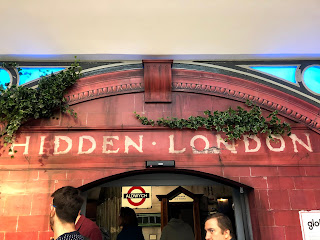Hidden London
 The Underground, if you don't have to use it for routine commuting, is something that can be endlessly fascinating. The first visit to London and the descent beneath the pavement to get on a train and go somewhere by a (mostly) direct route is the sort of commodity that can make the wide-eyed, naïve new resident take the Aldwych branch from the theatre in order to get back to Osterley one Saturday night after the theatres turned out.
The Underground, if you don't have to use it for routine commuting, is something that can be endlessly fascinating. The first visit to London and the descent beneath the pavement to get on a train and go somewhere by a (mostly) direct route is the sort of commodity that can make the wide-eyed, naïve new resident take the Aldwych branch from the theatre in order to get back to Osterley one Saturday night after the theatres turned out.Then, at the second attempt to live in London, there was another theatre incident that involved passing through a newly disused station that actually came back from the dead. At this point Mornington Crescent was closed. It was only once I'd come to London to live permanently that I learned about my first disused station, North End, which is between Hampstead and Golders Green, and can be seen as a wide section of tunnel. Taking my cue from Tom's Midnight Garden I tried to write a story about the ideal pub in the ideal street close to the station that is only open if you pass through it at midnight...
These days Hidden Underground visits run by the London Transport Museum are very popular, although North End remains off-limits to all but those that are willing to dare an incursion. The fascination with the history of the network as part of the city's development over the last 160 plus years includes the parts which aren't seen, or are no longer used. And the Museum has modified its temporary exhibition space in perhaps the most immersive and imaginative way. Many different exhibitions have appeared, and this is as different from a straight poster display. When you walk in, it's like entering a disused station, and the designers have made sure that the visitor gets the sound of the water and the nearby trains as the exhibition begins with the short-lived King William Street. I absolutely love the distressed and crumpled captions and the use of tape to fix the captions.
 |
| Tape surrounding captions |
 |
| Distressed paper caption, using typeface of the era |
 |
| It looks so real and potentially dangerous |


There's a large section on the use of stations in films (and this is mostly Aldwych) with a lengthly film featuring various clips. Aldwych was a strange little station very close to Holborn, which closed because the cost of upgrading the Otis lifts was prohibitive. It's a fun station to visit because it is still very accessible and is a time capsule of adverts.
 |
| Favourite Northern Line branch |
The adaptation of stations to become shops or frontages for hotels is shown in some of the archive photographs, and there are many pictures including York Road, beyond King's Cross, which is one of the perennial candidates for re-opening now that King's Cross itself has been massively improved and transformed. This isn't an exhibition where a dim view is taken of redevelopment, and the way the presence of the Underground results in the increase of property and the cost of it. The museum and this exhibition is about the love of London for all its peculiarities.
 |
| Re-used not demolished |
In addition to the exhibition there's a lavish hard-back book (£25) which tells the same story as the exhibition, but with more detail. This is a wonderful work, somehow better than the other tomes you can find about disused stations. For the enthusiast it's a fine companion to the book that shows the map of the Underground at 10 year intervals.
The London Transport Museum is a busy place, with long queues to enter, and a lot of children, activity and noise! That's not to everyone's liking but it demonstrates a love of museums that are well executed as well as a continuing interest in London and how moving people around has always been something of a conundrum that's being resolved and rethought all the time.



Comments
Post a Comment